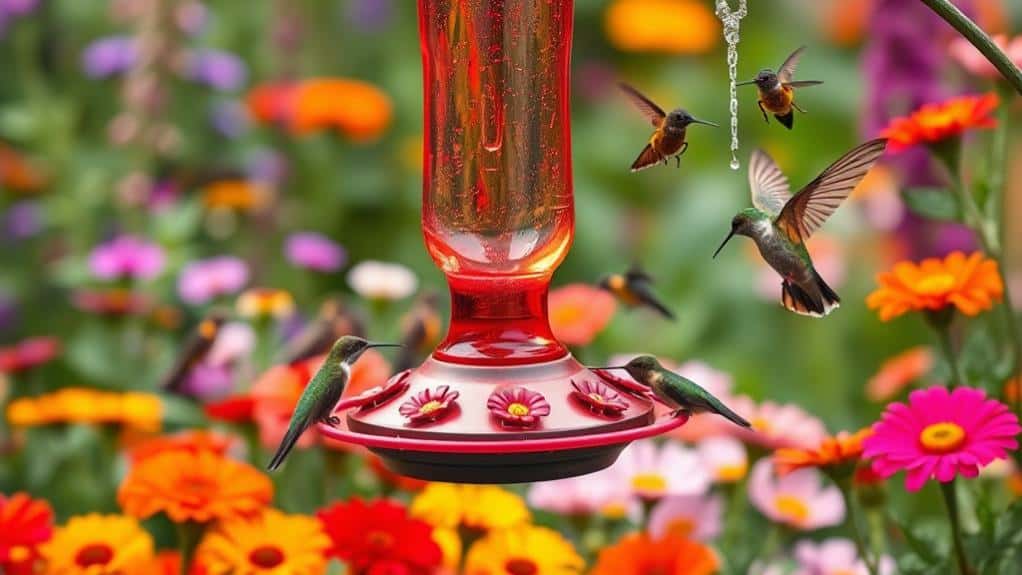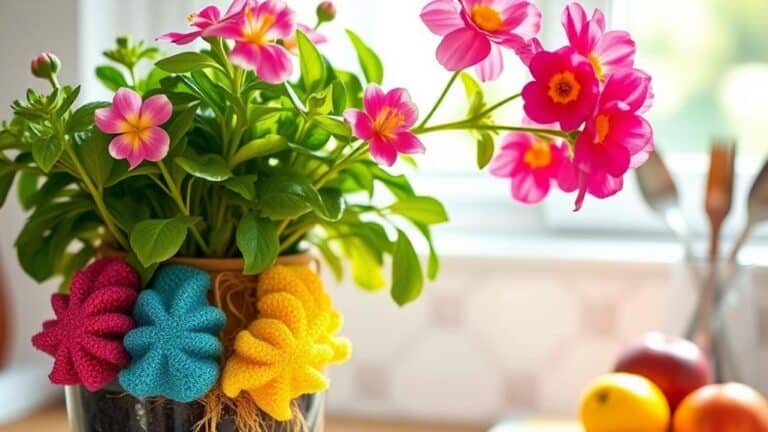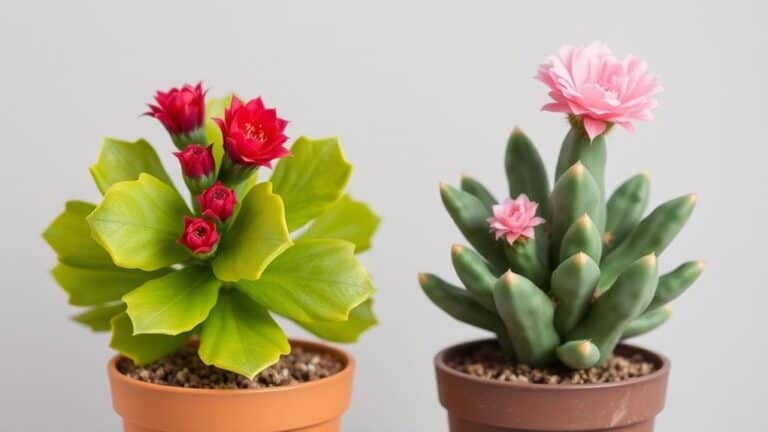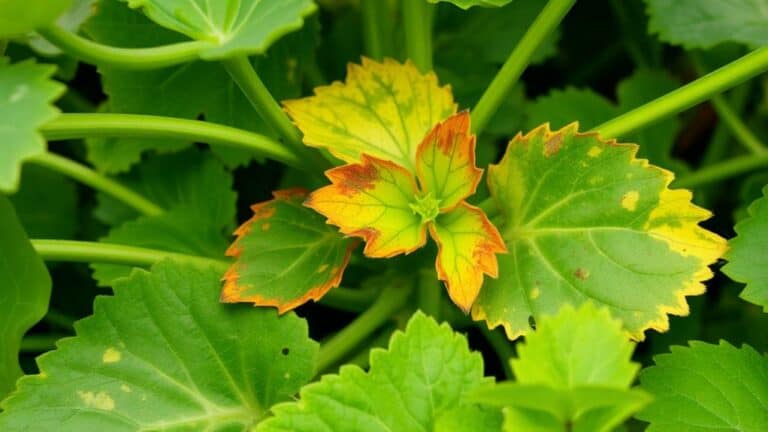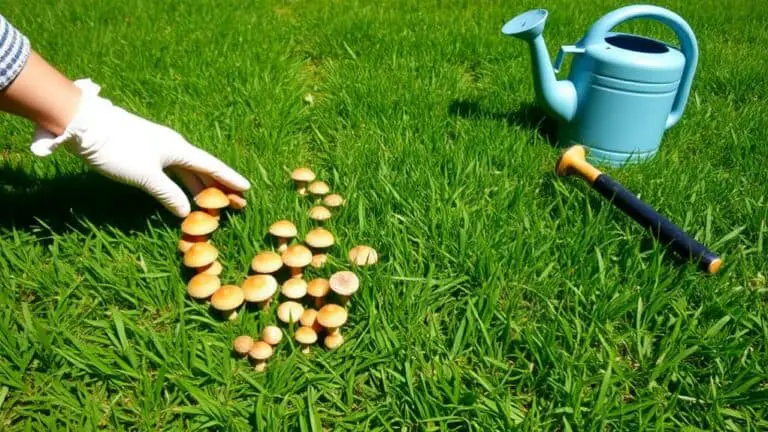Tips To Keep Wasps Away From Hummingbird Feeder
I once watched a hummingbird feeder turn into a battleground, with wasps aggressively taking over, much like an office meeting hijacked by a loud colleague. It's crucial to create a peaceful feeding environment for those delicate birds. Start by using saucer feeders with shallow designs, and add nectar guard tips to block insect access. Don't forget, wasps love yellow, so stick with red feeders. Cleaning the feeder every few days and moving it around helps, too. Curious about other strategies? Let's explore how to keep those pesky invaders at bay.
Use Saucer Feeders
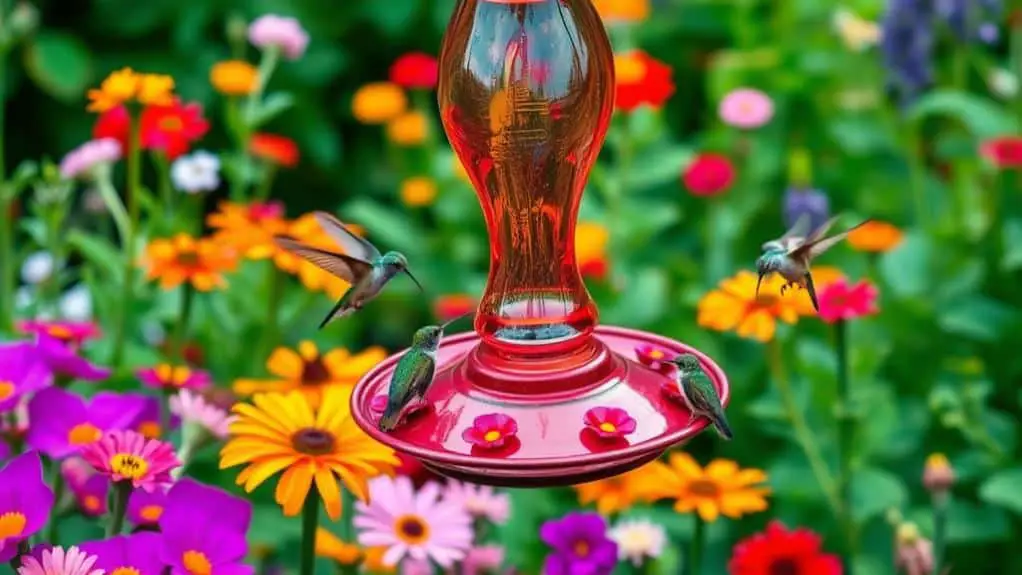
One of the most effective ways to keep wasps away from your hummingbird feeder is to use saucer feeders.
These feeders have a shallow design that keeps nectar away from the feeding ports, making it hard for wasps to reach but easy for hummingbirds.
Saucer feeders also minimize nectar spills, reducing the chances of attracting wasps and other pests.
Many of these nectar feeders come with built-in insect guards, which stop bugs from hogging all the nectar.
It's really important to do regular cleaning of your saucer feeders to remove any leftover sugar water that might attract wasps.
This will also guarantee the nectar stays fresh for your hummingbirds.
Add an Ant Moat
Adding an ant moat to your hummingbird feeder is a fantastic way to keep ants out and guarantee a clean feeding space for the birds.
These moats, typically about 3 inches wide and 1 to 2 inches deep, create a barrier that ants can't cross when filled with water.
Make sure to regularly refill and clean the moat to maintain its effectiveness and keep the hummingbirds happy!
Effective Ant Moat Design
Incorporating an ant moat into your hummingbird feeder setup is vital to keeping pesky ants away from the sugar water.
Ant moats should be at least 3 inches wide and 1 to 2 inches deep. Fill the moat with water to create a barrier ants can't cross. Some feeders come with built-in ant moats, making it easier to control insects.
Positioning the moat above the feeder, hanging from the hook, enhances its effectiveness. This design helps keep wasps away, especially when paired with feeders with bee guards.
Regularly refilling and cleaning the water source is essential to prevent algae growth and maintain its deterrent power.
This simple addition greatly improves your feeder setup!
Maintenance and Cleaning Tips
Keeping your hummingbird feeder clean and well-maintained is essential to ensuring it's a safe and inviting spot for hummingbirds while deterring unwanted guests like wasps.
Regularly clean your hummingbird feeders every 3-5 days with warm, soapy water. This prevents the nectar solution from spoiling and reduces insect attraction.
Attach an ant moat to your feeder; it acts as a barrier, stopping ants and other insects from reaching the sugar water. Always fill the ant moat with water and check it regularly.
When cleaning, address any leaks or spills around the feeder that could attract wasps. Replace the nectar solution every few days, using a mixture of 1 part sugar to 4 parts water. This keeps the feeder fresh and less appealing to wasps.
Benefits for Hummingbirds
Ever wondered how to keep ants from invading your hummingbird feeder? Adding an ant moat is a fantastic solution! This simple device forms a water barrier, effectively keeping ants out and ensuring the nectar remains fresh for your beautiful birds. Ant moats are generally 3 inches wide and 1 to 2 inches deep, making them a perfect fit for most hummingbird feeders. Regularly refilling and cleaning the ant moat prevents stagnant water and maintains its effectiveness. Many feeders now come with built-in ant moats, making it even easier to keep bees away and reduce competition for this crucial source of food. Your hummingbirds can feed more comfortably without having to compete with wasps and bees.
| Feature | Benefit | Maintenance |
|---|---|---|
| Water Barrier | Keeps ants away | Regular refilling |
| Built-in Design | Convenience | Easy to clean |
| 3" Width | Effective coverage | No extra tools |
| Nectar Protection | Clean food source | Fresh nectar |
Hang Feeders With Fishing Line
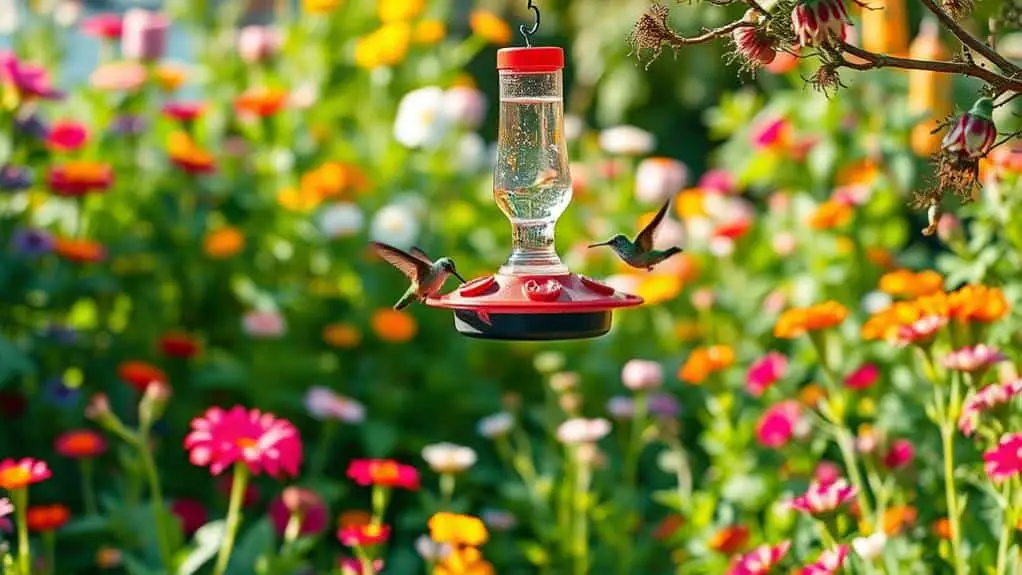
Hanging your hummingbird feeders with fishing line is a fantastic trick to keep ants and wasps away.
The thin, slippery surface makes it hard for these insects to reach the feeder, while the nearly invisible line keeps your garden looking beautiful.
Plus, the slight movement from the fishing line can confuse and deter wasps, ensuring your hummingbirds have an insect-free dining spot.
Prevent Ant Access
One effective way to keep ants away from your hummingbird feeder is by suspending it with fishing line. The slippery surface of the fishing line makes it hard for ants to climb, effectively preventing ant access to the nectar.
This simple trick not only helps keep insects away, but it also guarantees your feeder stays clean. Since fishing line is thin and discreet, it doesn't distract from your garden's beauty.
You can adjust the height and position easily, keeping the feeders away from ant trails. Remember to regularly check the fishing line for wear and tear to maintain its effectiveness.
Discreet Hanging Solution
Utilizing a discreet hanging solution like fishing line is an excellent way to keep wasps at bay while maintaining the aesthetic appeal of your garden.
The thin nature of fishing line makes it perfect for hanging feeders without attracting wasps and other insects. Because it's hard for ants to climb, your feeder stays cleaner too.
If you notice increased wasp activity, you can easily relocate the feeder, adjusting its height and position with minimal effort.
Additionally, the subtle movement created by the fishing line can deter wasps, as they prefer stationary food sources.
This method keeps the nectar accessible for hummingbirds while blending seamlessly into your garden, making it both practical and visually appealing.
Install Nectar Guard Tips
Installing nectar guard tips is a straightforward and effective way to keep wasps away from your hummingbird feeder.
These tips fit over the feeding ports, blocking access for bees, wasps, and yellow jackets while still letting hummingbirds feed comfortably. Made from silicone or plastic, they're easy to install on most standard feeders.
By using nectar guard tips, you can keep insects away from hummingbird feeders and prevent nectar from spilling, which often attracts pests.
It's also good to know that replacement yellow bee guards are available for glass bottle feeders, ensuring continued protection.
Remember to regularly inspect and replace worn or damaged nectar guard tips to maintain a clean and pest-free feeding environment for your hummingbirds.
Move Feeders Regularly

One great way to keep wasps away from your hummingbird feeder is to move it regularly.
By shifting the feeder just 3 to 4 feet every few days, you can confuse the wasps and disrupt their usual patterns, while the hummingbirds will still easily find their food.
This simple trick helps prevent insects from getting too comfortable and keeps your feeder a welcoming spot for your feathered friends.
Prevent Insect Habituation
Moving your hummingbird feeders just a few feet every few days can make a significant difference in keeping wasps at bay.
By frequently relocating the feeder, you can confuse insects like wasps, which rely on scent and visual cues to find food. This simple action helps prevent insect habituation and keeps the feeding ports primarily for your hummingbirds.
Here are some tips to help you keep insects away:
- Move feeders 3 to 4 feet every few days.
- Change locations during peak wasp activity seasons.
- Ensure new spots are still visible to hummingbirds.
- Avoid placing feeders too close to known wasp nests.
- Use multiple feeders and rotate their positions.
Maintain Bird Interest
Shifting the focus from preventing insect habituation, maintaining bird interest is just as important for guaranteeing your hummingbirds keep coming back.
By moving your hummingbird feeders just 3 to 4 feet, you can disrupt the foraging patterns of wasps, making it harder for them to locate the sugar water consistently. Hummingbirds are highly adaptable, so they'll easily find the feeders even after these minor adjustments.
This frequent relocation keeps the feeding area consistent for the birds while reducing insect infestations. Plus, moving the feeders regularly prevents the build-up of spilled nectar, which is a magnet for wasps and other pests.
Disrupt Insect Patterns
To outsmart wasps and keep them away from your hummingbird feeders, consider regularly relocating the feeders by just a few feet. By moving them 3 to 4 feet, you can confuse wasps and disrupt their search patterns.
This simple trick makes it tougher for them to find the feeders consistently, while hummingbirds adapt easily.
Here are some benefits of relocating feeders:
- Disrupts wasps' feeding routines
- Prevents wasps from becoming territorial
- Encourages hummingbirds to return
- Reduces wasp encounters near flowering plants
- Promotes a peaceful feeding environment
Regularly moving the feeders can prevent wasps from monopolizing the nectar, creating a more enjoyable and safe feeding experience for your hummingbirds.
Use Fake Wasp Nests
Creating an unwelcoming environment for wasps around your hummingbird feeder can be as simple as using fake wasp nests.
These nests work as a visual deterrent because wasps are territorial and will avoid areas they think are already claimed. To deter insects effectively, hang fake nests in sheltered spots to protect them from rain.
It's essential to remove any active wasp nests first to prevent confusion. Placing multiple nests around the feeding area can reinforce the idea that it's a claimed territory, keeping real wasps at bay.
Regularly check and maintain the fake nests to guarantee they stay intact and continue to serve as an effective visual deterrent.
It's an easy and efficient way to keep your hummingbird feeder wasp-free!
Plant Pollinator-Friendly Flowers
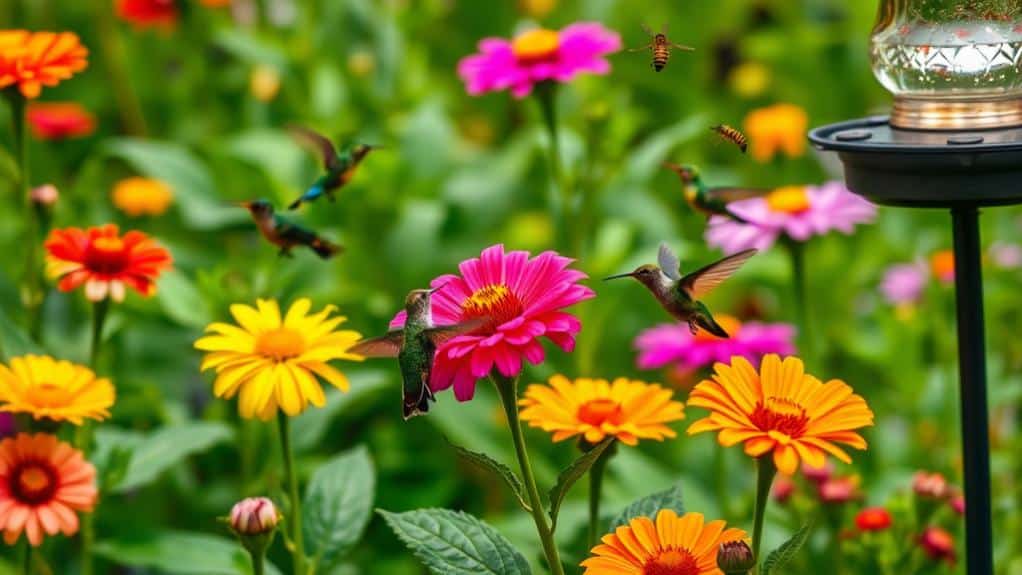
While fake wasp nests can be incredibly effective, another natural strategy is to plant pollinator-friendly flowers. By planting a variety of nectar-rich flowers, you can attract bees away from hummingbird feeders. This creates a natural diversion that benefits the entire garden ecosystem.
Consider adding these flowers to your garden:
- Trumpet vine
- Bee balm
- Fuchsia
- Nasturtiums
- A mix of perennials and annuals
These plants not only draw bees and wasps to different areas but also enhance the overall pollinator habitat. By strategically positioning bee-friendly flowers away from the feeders, you can keep wasps and bees busy elsewhere.
Regularly maintaining a selection of pollinator-friendly flowers guarantees a sustainable environment for both hummingbirds and beneficial insects.
Clean Feeders Frequently
Cleaning your hummingbird feeders frequently is key to keeping wasps at bay. By washing your feeders every 3-5 days with warm soapy water, you'll prevent mold and nectar contamination, which can attract wasps and other pests.
Make sure to rinse thoroughly to remove any soap residue that could deter hummingbirds. Regularly check for leaks and spills around the feeder; excess sugar water can easily draw wasps closer.
Changing the sugar-water solution often keeps it fresh for hummingbirds and reduces the chances of attracting wasps. After cleaning, hang your feeders in shaded areas to slow nectar fermentation and minimize odors that might attract wasps.
These steps will help create a safe, wasp-free feeding environment for your hummingbirds.
Offer Alternative Water Sources

Providing alternative water sources can considerably help in keeping wasps away from your hummingbird feeders. By offering other hydration options, you can divert wasps from the sweet nectar meant for hummingbirds.
Here are some tips to get started:
- Place shallow dishes of fresh water around your garden to attract wasps.
- Confirm these water sources are far from the hummingbird feeders.
- Regularly clean and refill the water dishes to keep them appealing and prevent mosquito breeding.
- Add rocks or pebbles to the water dishes, giving wasps a safe landing spot.
- Consider using birdbaths or small fountains to provide varied water sources and reduce competition at feeding sites.
Avoid Yellow Accents
Choosing the right hummingbird feeder plays a crucial role in keeping wasps away. Wasps are naturally drawn to yellow accents, much like they're to yellow flowers.
To reduce attraction, I recommend choosing hummingbird feeders that are red or have minimal yellow components. This simple change can make a big difference. When you avoid yellow accents, you create a less appealing environment for wasps, helping to maintain a peaceful space for your hummingbirds.
Look for feeders with feeding ports designed without yellow elements. Many wasp species are territorial, and yellow can signal floral resources, increasing competition.
Frequently Asked Questions
How to Get Rid of Wasps Around a Hummingbird Feeder?
I get rid of wasps around my hummingbird feeder by using natural repellents and adjusting feeder placement. I also change the feeding schedule, try alternative feeders, and move the feeder to keep attracting hummingbirds without wasps.
How Do I Keep Wasps Out of My Bird Feeder?
I keep wasps out of my bird feeder by using natural repellents and smart feeder placement. I attract hummingbirds with seasonal strategies like frequent feeder relocation and diligent feeder maintenance. These methods guarantee my feeders stay wasp-free.
Can You Spray Wasp Spray on Hummingbird Feeder?
You shouldn't spray wasp spray on a hummingbird feeder. Instead, understand wasp behavior and adjust feeder placement. Use natural repellents and vary feeding times to avoid wasps, ensuring hummingbird attraction without harming them.
Does Vicks Keep Wasps Away From Hummingbird Feeders?
I've found that Vicks' effectiveness as a natural repellent depends on wasp behavior and surrounding conditions. It can deter wasps from feeding areas, but for garden safety, don't rely solely on it. Combine methods to protect your feeders.
Conclusion
By following these tips, you'll create a safe haven for your hummingbirds while keeping pesky wasps at bay. Remember, a clean feeder is a happy feeder, so keep it sparkling and fresh. Moving the feeders and using red accents will confuse wasps, making your yard a hummingbird paradise. Don't forget to plant flowers and add ant moats to enhance the environment. With a bit of effort, you'll enjoy the beauty of hummingbirds without the wasp hassle!

